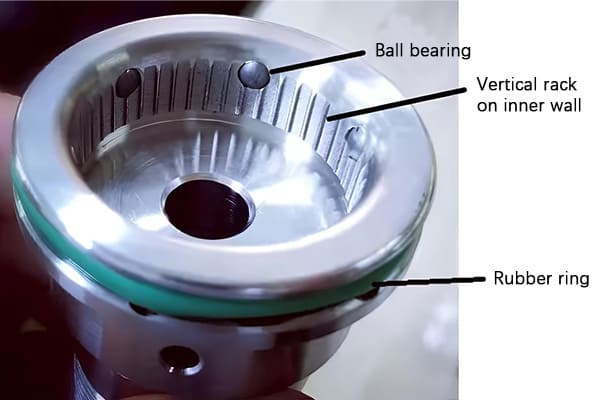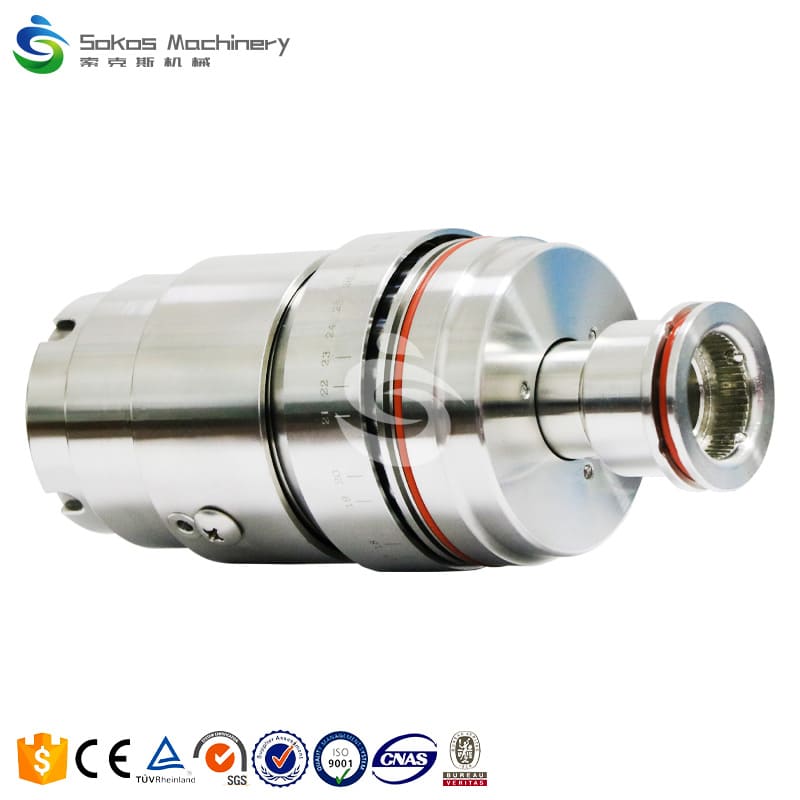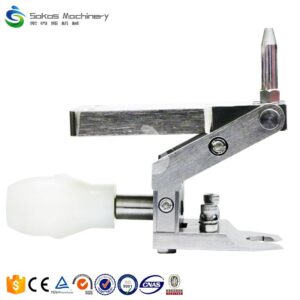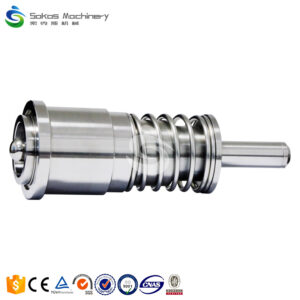Description
Fully Automatic Filling Machine Spare Parts Filling Capping Head
Compatibility of capping heads and bottle caps
Filling machine capping head refer to the general term for parts used to grab and tighten bottle caps on filling equipment. Generally, the more capping heads there are on a filling equipment, the faster the filling speed. For example, the number of common capping heads on a filling line ranges from 6 to 24, and the corresponding production speed ranges from thousands per hour to tens of thousands per hour.
Let us first briefly introduce the principle of capping. The capping head contains an even number of metal balls along its inner wall and a ring of rubber around the outer wall. As the head grips the cap, the rubber ring deforms elastically and pushes the metal balls inward. These balls then grip the cap and lift it. Inside the head, the vertical rack engages with the anti-slip teeth on the cap. As the capping head both rotates and revolves, it tightens the cap securely onto the bottle mouth.

The compatibility between the screw capping head and the bottle cap is usually reflected in the following aspects:
1. The relationship between the inner diameter of the ball and the outer diameter of the anti-slip teeth of the bottle cap
The inner diameter of the ball is typically designed to be about 1 mm smaller than the outer diameter at the top of the bottle cap’s anti-slip teeth. If the two diameters are too close, the ball won’t apply enough force, causing the cap to slip during gripping. On the other hand, if the size difference is too large, the ball grips too tightly, making it difficult to release the cap from the screw capping head after sealing.
2. Relationship between the inner diameter of the vertical rack on the inner wall of the screw capping head and the root diameter of the anti-skid teeth of the bottle cap

As mentioned, the vertical rack inside the screw capping head engages with the bottle cap’s anti-skid teeth. The rack’s inner diameter is usually about 0.1 mm larger than the root diameter of the teeth. If the gap is too large, the contact area shrinks, causing slippage and poor tightening. If the gap is too small or equal, the teeth may drag after screwing, making the cap hard to release from the head.
3. Relationship between the internal depth of the capping head and the height of the bottle cap body (excluding the anti-theft ring and the convex edge)

The capping head’s internal depth should be slightly less than the cap height to ensure proper top-to-top contact. Some customers reported unstable sealing, and on-site inspection revealed non-standard capping heads with depths greater than the cap height. This caused poor contact, squeezed the cap’s convex edge, and led to inconsistent sealing.
4. The relationship between the number of internal racks of the capping head and the number of anti-slip teeth of the bottle cap
In most cases, the number of internal racks in the capping head is set to half the number of anti-slip teeth on the bottle cap. For instance, a standard 3025 bottle cap has 90 anti-slip teeth, so the optimal number of internal racks in the capping head is 45. This 1:2 ratio ensures a proper engagement between the two components. However, technicians have found that some bottle cap manufacturers intentionally deviate from the standard tooth count. As a result, the rack spacing and number of internal racks on the capping head no longer align properly, making it difficult to achieve consistent capping performance and leading to instability during operation.
Why Choose Us
Direct Manufacturer: With over 10 years of experience in developing and manufacturing beverage and liquid food filling machines. Our plant spans 4000m², and we have independent property rights.
Professional Export Team: We offer stable product quality, fast delivery, and clear communication, ensuring smooth international transactions.
Custom Manufacturing: Our skilled technical team can design machines in various sizes and configurations to meet your unique specifications.
Strict Quality Control: We never ship equipment without customer approval. Every machine undergoes 24-hour testing before shipping, and we ensure quality is controlled at every production stage.
12-Month Warranty: All our equipment comes with a 12-month warranty, and we provide lifetime technical support for all products.
Fast Spare Parts Availability: We supply spare parts quickly and at cost price, minimizing downtime and ensuring operational continuity.




